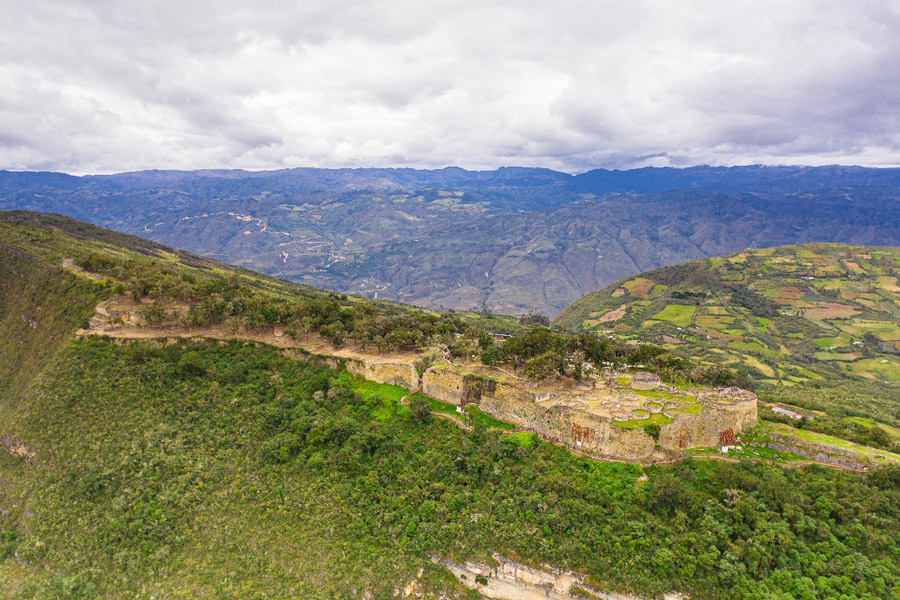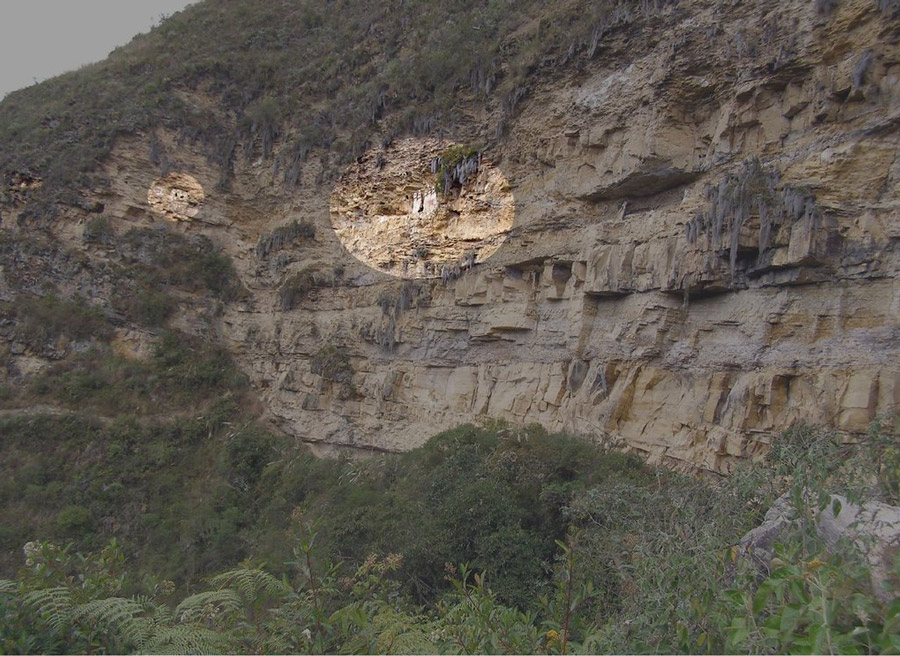Hidden in the mountains of Northern Peru, far from the tourist hotspots of Machu Picchu and Cuzco to the south, lies an altogether stranger structure, built by a culture far older than the Inca.The Chachapoyas, the Cloud Warriors of the Andes, built a great walled settlement named Kuelap, a fortress hidden deep in the Andes.
This enigmatic, walled stronghold was created in the 6th century AD, 700 years before the greatness of the Inca. But they didn’t just leave behind their stonework. This Peruvian region is also famed for its mummies, the largest collection of undisturbed preserved bodies in Peru.
The dead bodies are of the elites of Chachapoyas civilization, preserved using Inca traditions and techniques, and standing high on cliffsides overlooking the valley settlements. More are being found to this day – a huge cache of bodies was uncovered in 1997 to the south of Kuelap, in the Laguna de Los Condores region.
The Cloud Warriors
Human occupation in the Kuelap area started around 2,400 years ago, in 400 BC. Here the Chachapoyas built their great fortress in the 6th century, adding most structures from around 900 AD to 1100 AD. They continued to build on this site right up to the Inca conquest during the 1400s.
The Fortress of Kuelap was the pre-Inca Chachapoyas society’s political center, which prospered here from 900 AD up to 1400 AD. What they left behind was monumental and massive – a castle in the clouds almost 2,000 feet (600 m) long, perched high the Utcubamba River Valley surrounded by stone walls 62 feet (19 m) high.

But even this massive fortress could not save the Chachapoyas people from the Inca conquest around 1470 AD. Yet even in defeat they endured, resisting the unsuccessful attempts of the Inca to remove them from their ancestral homelands. In 2017, a genetic study showed that the indigenous people residing in the area these days remain genetically Chachapoyas.
The Inca reign lasted only a century, before they and the Chachapoyas region were in turn conquered by the Spanish around 1570 CE. After that, the region was abandoned for several hundred years, until it was discovered anew by a judge from the nearby city of Chachapoyas in 1843. The area and the culture remained in obscurity up until the 1980s, and is only now being understood again.
- Kaunos: An Ancient City of Ruins and Rock Cut Tombs
- Machu Picchu Facts – 11 Fascinating Details of the Inca Citadel
Kuelap is now being considered as a candidate for UNESCO World Heritage Site status. If it becomes a World Heritage Site, then it will gain more international recognition and the protection it needs to understand this unique culture.
A Fortress In The Sky
The site Kuelap is a fully walled settlement with the long axis aligned north-south. The walls fully enclose an area 360 feet (110 m) wide and 1,920 feet (584 m long), making up an area of some 15 acres (6 hectares).
The walls are built of limestone blocks, some weighing as much as 3 tons (2,700 kg), and each block is finely worked. Some are carved with animal forms, or strange faces.

The city has just three entrances, two to the east and one to the west. The main entrance seems to be built entirely for defense, rising steeply as it passes into the interior of the complex, and continuing to narrow until there is space for just one person.
Inside the walls there are more than 550 structures, almost all of them circular, although a handful have straight walls. Next to the long, straight lines of the curtain wall the circular buildings within seem very different.
The walls of the circular structures, which rise to the height of a man, are often decorated with rhomboid friezes and zig-zag shapes, built into the stone. Some structures have been restored, others lie in ruin, hidden beneath the thick vegetation and undisturbed save for the occasional passing llama.
Some structures are clearly focal points for the complex. On the settlement’s southern side, there is a much larger building, a tower with an inverted cone shape 18 feet (5.5 m) high, dubbed “El Tintero,” meaning “inkwell” in Spanish. The structure is also referred to as Templo Mayor (“main temple”), and some archaeological remains found there suggest that the building might have been utilized as a solar observatory.

On the northwestern side, there is Pueblo Alto (“high town”), an inner area with walls 38 feet (11.5 m) high and is accessed by two entrances. Close by this inner complex is the Torreón (“tower”), the tallest building at Kuelap and apparently used to defend the site.
Throughout, the stones continue their zoomorphic and geometric decorations. And it is here that we find evidence of how the Chachapoyas treated their dead before the Inca conquest: numerous burials have been found in walls and in the circular structures. To date, over 100 skeletons have been discovered buried this way, before the burial tradition was replaced by mummification of the dead after the Inca invasion.
Cliffside Burials And Inca Mummification
The dramatic cliffs and steep mountains across the region are filled with ruins, burial sites, sarcophagi, mummies, and other artifacts left behind by the Chachapoyas people and their Inca conquerors. A historian of the Chachapoyas, Peter Lerche said that nearly 90% of the archaeology in the area remains undiscovered.
- Hanging Coffins of China: Mysteries Along the Yangtze
- Cahokia Mounds: The Largest Ancient City in North America
But the most striking and visible impact the Chachapoyas left on the landscape comes from the cliffside burials. Tombs cut into the sheer rock surface, and mummified remains held in anthropomorphic jars, lend an eerie presence to the landscape. It is as if the dead are watching you, from their inaccessible viewpoints high above.
It is not even clear how the dead were transported to their final resting places – the landscape in the area is extremely wild and difficult to traverse and placing the dead on sheer cliff faces must have been difficult and dangerous. But the effect is spectacular.

According to anthropologist and mummy expert Sonia Guillen, the significance of the area should never be underestimated. The cache of mummies found at Laguna de Los Condores provided an insight into organic human remains.
These remains offer far more opportunities for study than skeletons. Scientists are able to test the internal organs which could help trace diseases. However, the mummies were vulnerable to looting and had to be removed after several were damaged or stolen. Now there are 219 mummies in Leymebamba Museum, south of Kuelap, awaiting study.
Skeletons in Foundation and Walls
The city is around 700 years older than the Inca’s Machu Picchu site, and is every bit as mysterious Archaeologists believe that Kuelap was a religious and political center of the Chachapoyas, but what more? Did they cohabit with their dead, buried in the walls? If the site was purely ceremonial, why was it built with such a focus on defense? If for trade, why so inaccessible and remote?
In previous generations, the site was a two day hike up into the mountains. However, with the introduction of a new cable car tourists can reach the sky fortress in an hour. With the support of the government of Peru this Machu Picchu in the north could finally receive the fame and recognition it deserves.
Top Image: Chachapoyas Cliffside Mummies. Source: Mike Carroll / CC BY-NC-SA 2.0
By Bipin Dimri